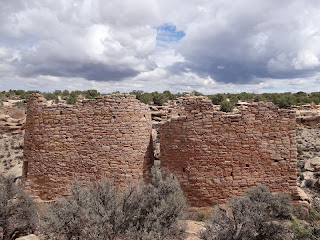Monday, August 27, 2012
August 24: The Montezuma Valley
We found an inexpensive campsite in Blanding that turned out to be very nice. Not only did we have grass on which to pitch our tent,
but really hot showers. Best of all, there were few other campers, which meant that we had the recreational facilities all to ourselves.
Blanding is at the foot of the sacred Abajo Mountains. It continued to be stormy, but we decided to venture forth today anyway.
We headed 40 miles west, toward the Colorado Border, on back roads. Our destination was the Hovenweep Ruins site.
This is Navajo country, and we even passed a red bus that was part of the Navajo Transit system. It brought Navajo children from the reservation areas into Blanding for school. We have met many Navajo children in the Blanding library while we are blogging and they are using computers in an after-school program. We even passed a Navajo hogan and ceremonial center on our way to Hovenweep.
And we stopped at the Hatch Trading Post, which has been bartering with the Navajos for over a century.
Hovenweep was better than we expected and has inspirational qualities.
The National Park System only runs one of six sites, and we only had time to visit this one.
Some background: Hovenweep is located on what is called the Sage Brush Plain that runs from Blanding all the way over to Mesa Verde in Colorado. Even today, it is a fertile area in the Cortez, Colorado, vicinity.
Between 1200 and 1250 this large region of canyons was inhabited by ancient Puebloan villages, each of which numbered in the hundreds of inhabitants. It was a heavily populated area before it was totally abandoned by the Anasazi by 1280. Mesa Verde was a relatively small settlement in comparison with places like Hovenweep, Yellow Jacket, and Goodman Point, places we hope to visit.
Hovenweep was a complex of sophisticated masonry buildings surrounding both sides of the Little Ruin Canyon in SE Utah.
It must have been an impressive and imposing sight for visitors. Large, multistoried buildings revealed a highly structured society.
These buildings were constructed both on top of the mesa and along the talus slopes on both canyon sides. Tall, square towers served as defensive watchtowers.
Circular and D-shaped buildings had special ceremonial purposes, and also had small openings that kept watch against enemies.
Archeologists do not know who these "enemies" were, but they threatened to steal the wealth of the community, or possibly destroy it violently.
The masonry skill is every bit as impressive as masonry at Mesa Verde or Chaco Canyon. Stones were carefully chiseled and fitted together, whether the buildings were square, cylindrical, or D-shaped.
Exterior and interior surfaces were pecked smooth. Buildings could even be built into the boulders of the canyons.
From the canyon floor, the settlement (about 500 residents) would have spoken of the dominance of humans over the landscape.
Later that day, we took a backcountry road to return to Blanding. We drove up the Montezuma Creek Canyon. This valley was slightly east of Hovenweep. Between 600 and 1250, it was heavily populated with early and late Pueblo settlements, though desolate today
--except for oil and gas drilling tanks and trucks.
The canyons are filled with hidden petroglyphs and ruins.
We stopped at one prominent site, with panels about 200 yards long. Pueblo art was heavily weathered, but the probable fertility symbols were still evident.
Again, the artistry of the chippers was evident.
There was also a lot of evidence of later Ute rock art. See if you can figure out why many of the figures in this panel could not be pre-historic, although some of the original images may, in fact, have been ancient puebloan.
We drove seven miles further up the dirt road
to a small ruins site, called Three Kiva Pueblo.
Its isolation and quiet held a definite appeal. It was open to the public to explore--with care and respect, of course.
In its day, it would have been just one of many small pueblo household settlements in the valley. Each had its own family or clan "kiva," made of masonry now rather than simply a pithouse.
The beauty of this site is that one can linger and imagine the human activities that must have gone on inside the kiva 1,000 years ago.
Subscribe to:
Post Comments (Atom)

























No comments:
Post a Comment